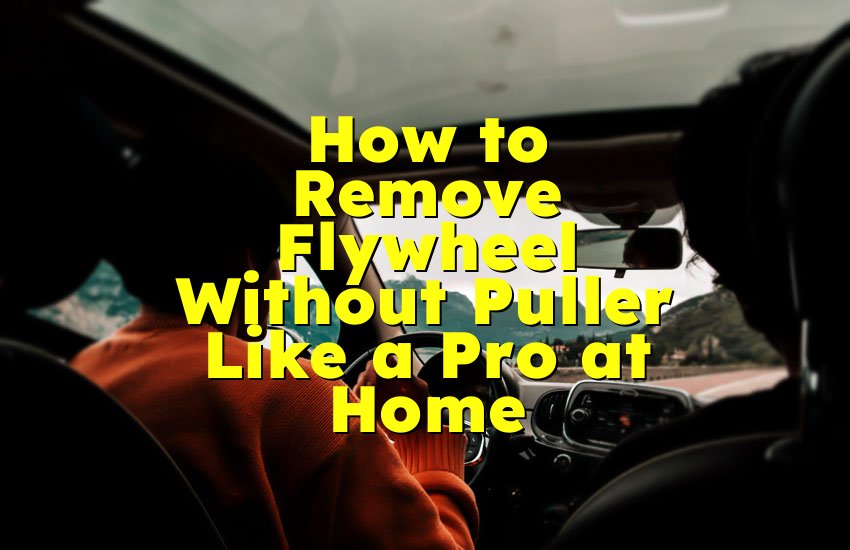As an Amazon Associate, I earn from qualifying purchases at no extra cost to you.
How to Remove Flywheel from Engine Easily Like a Pro
Sometimes when an old engine starts making that rough rattling sound, it's often the flywheel crying for help. I remember once trying to start my car and hearing a strange metallic clunk. That was my clue something deeper was wrong. Removing the flywheel can sound tricky, but with the right steps, it's totally doable at home. Let's go through it together safely and smoothly.
Disconnect the battery and remove the transmission safely before accessing the flywheel. Loosen the bolts in a crisscross pattern to avoid damage. Mark the flywheel position for accurate reinstallation. Use a flywheel holding tool to prevent rotation. Inspect the rear main seal for leaks before reassembly. Finally, clean the flywheel surface and torque bolts to the manufacturer's specifications for a perfect finish.
Preparing the Workspace and Tools
Before diving into the job, it's crucial to set up a clean and organized workspace. Imagine working under your car and realizing halfway through that your socket wrench is missing. Frustrating, right? Gather all tools you need first — wrenches, socket set, flywheel holding tool, jack stands, and safety gloves. Having everything within reach saves time and keeps things safe.
Always park your car on a flat surface and use wheel chocks to prevent movement. Then disconnect the battery. This may sound small, but it's an important safety habit because the starter motor can engage accidentally if left connected. You really don't want that surprise. Take a few minutes to double-check the area around the car for stability before sliding underneath.
A sturdy jack and jack stands are your best friends here. Raise the vehicle carefully, and never trust a hydraulic jack alone to hold the car up. I once knew a friend who used only a jack, and it slipped while he was under it — not fun at all. So, always support the car properly before you start removing anything.
Lastly, keep a magnetic tray or small container nearby for bolts and washers. It's amazing how quickly those tiny pieces can roll away. You'll thank yourself later when reassembly time comes.
- Gather all required tools before starting
- Park on a flat surface with wheel chocks
- Disconnect the battery for safety
- Use jack stands to support the vehicle
Disconnecting the Transmission
The next major task is separating the transmission from the engine. It sounds big, but with patience, it's manageable. Start by draining the transmission fluid if your vehicle requires it. This keeps things tidy and prevents messy spills later. Remove the driveshaft or CV axles, depending on whether your car is rear-wheel or front-wheel drive.
Then, locate the transmission bolts that connect it to the engine block. These bolts are usually around the bell housing area. A long socket extension makes this part easier, especially for the top bolts that are hard to reach. Keep track of each bolt's position — they can be slightly different in length.
When all bolts are out, place a transmission jack or floor jack under the transmission to support its weight. Once you gently separate it from the engine, slide it back a few inches. Don't rush or yank it; a slow, steady movement prevents damage to the input shaft. It might need a little wiggle to come free.
If it feels stuck, check if any hidden bolts or brackets are still attached. Many people miss the small bolts near the starter area or lower brackets. Take your time. The moment you see the clutch or torque converter exposed, you know you're almost there.
- Drain transmission fluid if needed
- Remove driveshaft or CV axles
- Support transmission with a jack
- Slide it back slowly after removing bolts
Accessing and Marking the Flywheel
Once the transmission is out of the way, the flywheel becomes visible. This round metal disc connects directly to the crankshaft, transferring power from the engine to the gearbox. Before removing it, mark its position using chalk or a paint pen. This helps align it properly during reinstallation later.
You'll notice several bolts arranged in a circular pattern around the flywheel center. These bolts are usually tight and might be coated with thread-locking compound. Before loosening them, insert a flywheel locking tool or wedge a screwdriver between the flywheel teeth and engine block to stop it from spinning.
Loosen the bolts in a crisscross or star pattern. This even release prevents warping and maintains balance. Once all bolts are out, carefully lift the flywheel off. It's heavier than it looks, so keep a firm grip. If it feels stuck, give it a light tap with a rubber mallet — not metal, as that could damage it.
As soon as you remove it, place it on a clean surface. Avoid dropping it or letting dirt get on the clutch surface. A small scratch or oil stain can cause vibration later when driving. Keeping things clean now saves big trouble down the road.
- Mark flywheel position before removal
- Use locking tool to hold it still
- Loosen bolts in crisscross pattern
- Handle flywheel gently to prevent damage
Inspecting the Rear Main Seal and Flywheel Surface
With the flywheel off, take a moment to inspect the rear main seal behind it. This small ring keeps oil from leaking out of the engine's crankshaft area. If you notice any oil residue or wet spots, it's a sign the seal might need replacement. Replacing it now is much easier than after everything's reassembled.
Next, check the flywheel's condition. Look for cracks, burn marks, or uneven surfaces. Overheating from a worn clutch can cause discoloration or warping. If you see any rough spots, take it to a machine shop for resurfacing. It's affordable and ensures smooth clutch engagement when you reinstall it.
Sometimes, tiny cracks near bolt holes might seem harmless, but they can grow and cause vibration. It's better to replace the flywheel entirely if the damage looks serious. Clean it thoroughly with brake cleaner before reuse. Even a small bit of oil can cause clutch slippage.
Inspect the ring gear teeth too. Worn or chipped teeth can cause starter motor grinding sounds. Replacing the ring gear now saves you from frustrating no-start problems later. Good inspection now means peace of mind after reassembly.
- Check rear main seal for leaks
- Inspect flywheel for cracks or burns
- Replace or resurface if damaged
- Clean flywheel before reinstallation
Reinstalling and Torquing Everything Back
Once inspection is done, it's time to reinstall the flywheel. Align the marks you made earlier so it sits exactly as before. Hand-thread all the bolts first to prevent cross-threading. Then, tighten them gradually in a crisscross pattern using a torque wrench. Always follow your car manufacturer's torque specs — over-tightening can cause cracks or imbalance.
Apply a small dab of thread locker on each bolt before tightening. This helps keep them secure against vibration. While tightening, keep the flywheel locked using the holding tool. It makes the job smoother and keeps the crankshaft steady.
After all bolts are secure, give the flywheel a gentle spin by hand to ensure it moves freely and evenly. Listen for scraping or grinding sounds — those mean something's off. Once everything feels smooth, you're ready to reinstall the clutch assembly or torque converter.
Reattach the transmission carefully by aligning the input shaft with the clutch disc or torque converter hub. It may take a little wiggling to fit perfectly. Don't force it; gentle movement and alignment are key. Secure all bolts again, and double-check everything before lowering the vehicle.
- Align marks before tightening
- Use torque wrench with correct specs
- Apply thread locker to bolts
- Recheck flywheel rotation and smoothness
Testing and Final Adjustments
Once reassembly is complete, reconnect the battery and start the engine. Listen closely for unusual noises like rattles or vibrations. A properly installed flywheel should sound smooth, almost invisible in operation. If you hear a sharp metallic tapping, recheck the bolt torque.
Take the vehicle for a short drive to confirm smooth gear engagement. Shifting should feel consistent without jerks or clutch slippage. If the clutch feels soft or spongy, air might be trapped in the hydraulic system. Bleed it properly to restore pressure.
After driving a few miles, it's smart to inspect underneath for leaks or loose components. Sometimes bolts can settle slightly after heat cycles. Retorquing them after a short run helps keep everything tight and reliable.
Finally, reflect on the process. Removing and reinstalling a flywheel takes patience and attention to detail. But once you've done it, you gain a deeper understanding of your engine's heartbeat — and that's pretty rewarding for any car lover.
- Listen for unusual sounds after reassembly
- Check clutch feel and engagement
- Inspect for leaks or loose parts
- Retorque bolts after short drive
Final Thoughts
Removing a flywheel from an engine isn't about brute force — it's about careful preparation and precision. Once you understand each step, the process becomes much smoother. It's one of those satisfying car jobs that teach patience and attention to detail. With the right tools and a calm mindset, you'll handle it confidently and bring your engine back to perfect balance.
| Task | Tools Needed | Key Tip |
|---|---|---|
| Prepare workspace | Jack stands, wrenches | Keep tools organized before starting |
| Disconnect transmission | Socket set, jack | Support weight before removing bolts |
| Mark flywheel position | Paint pen or chalk | Helps during reinstallation |
| Remove flywheel bolts | Flywheel lock tool | Loosen evenly to avoid warping |
| Inspect flywheel | Flashlight, brake cleaner | Look for cracks or hot spots |
| Replace rear main seal | Seal puller, new seal | Replace if any oil leak visible |
| Reinstall flywheel | Torque wrench | Follow proper torque specs |
| Final test drive | None | Listen for vibrations or clutch slip |
Frequently Asked Questions (FAQs)
Is it hard to remove a flywheel from an engine?
It might seem challenging at first, but once you understand the process, it becomes manageable. The hardest part is often separating the transmission safely. Using proper tools like a flywheel lock and torque wrench makes it smoother. Take your time, follow each step carefully, and never rush. Even if you're new to DIY repairs, patience is your best tool here.
Can I remove a flywheel without special tools?
You can, but having a few proper tools makes the job safer and faster. A flywheel locking tool and torque wrench are especially important. Without them, bolts may strip or the flywheel could spin while loosening. You can improvise carefully with a sturdy screwdriver for locking, but precision tools always give better results and peace of mind.
Do I need to replace the flywheel bolts?
Some manufacturers recommend replacing them every time because they stretch slightly when torqued. Others can be reused if in good shape. Inspect them for rust, thread damage, or wear. If you're unsure, replacing them is cheap insurance against failure. A new bolt set ensures secure fastening and avoids vibration issues later.
Is it necessary to resurface the flywheel?
Yes, if you see any glazing, heat marks, or uneven wear. A smooth surface ensures consistent clutch engagement. Most machine shops can resurface a flywheel quickly and affordably. Skipping this step can lead to clutch chatter or vibration. Think of it as giving your flywheel a fresh, clean handshake with the clutch.
Can I remove the flywheel with the engine in the car?
Yes, in most vehicles you can, though it's tight on space. As long as the transmission is out, you can access the flywheel. However, make sure the car is properly supported and stable. Working underneath requires extra caution, so never skip the safety steps or rush the process.
Do I have to disconnect the battery first?
Absolutely. It's one of the first and most important steps. The starter motor is directly linked to the flywheel, so keeping the battery connected can cause accidental engagement. That's dangerous when you're working near rotating parts. Disconnecting takes seconds but ensures complete safety during the whole process.
Is cleaning the flywheel before reinstalling necessary?
Definitely. Even small traces of oil, grease, or fingerprints can affect clutch friction. Use brake cleaner and a clean rag to wipe it thoroughly. Make sure it's dry before mounting. This step prevents clutch slip and ensures a smooth, strong grip once you're back on the road.
Do I need to torque the flywheel bolts exactly?
Yes, precision matters here. Under-tightening can cause bolts to loosen, while over-tightening may crack the flywheel or crankshaft flange. Always follow the specific torque values listed in your car's manual. Using a torque wrench ensures accuracy, safety, and long-term reliability after installation.











